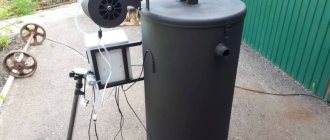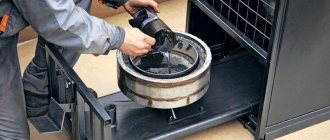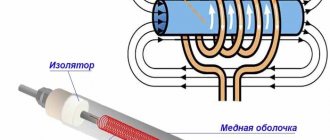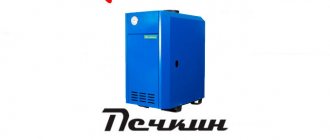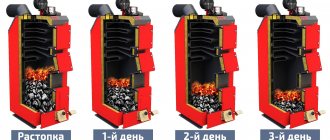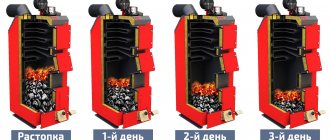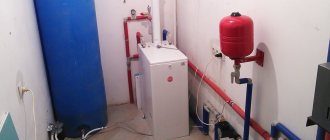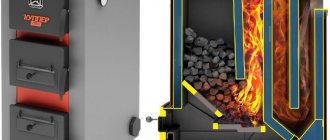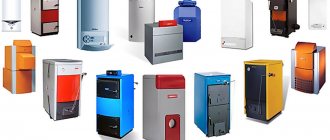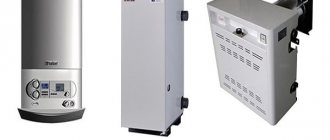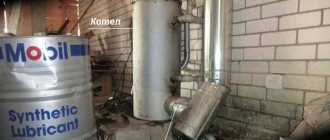The operating costs of waste oil heating boilers are among the lowest, often even lower than the cost of gas. The process of installing heating equipment is also cheap, and boilers operating on exhaust gas are comparable in reliability to their gas or diesel counterparts.
However, they still have not gained wide popularity due to the high initial cost (usually from 100 thousand rubles), the need for constant daily care, and less functional automation and controls (with the exception of extremely expensive models). However, if you understand all the advantages and disadvantages of oil boilers, the choice may well be justified.
What are waste oil boilers?
Why are they needed and how are they used?
Organization of a boiler room with a waste oil boiler and internal fuel storage.
The main reasons for choosing boilers with a waste oil burner are:
- the place of residence is temporarily unavailable or is not expected to have a gas main;
- financial benefit, because the cost of development is one of the lowest among fuel options;
- free access to large volumes of mining or the possibility of purchasing it for a symbolic price (places of greatest distribution - service stations and auto repair shops, agricultural enterprises, any type of vehicle fleets, factories, railway depots);
- large heated area, from 600-800 m2.
No permit is required to install heating equipment, which further simplifies the installation process. You can store fuel both inside the house (in the boiler room) and outside: for the heating season, for an average house with an area of 100-150 m2, 1.5-2.3 tons of fuel is enough.
Design and principle of operation
Standard high-quality waste oil boiler EnergyLogic waste oil boiler (USA).
Boilers with a water heating circuit operating on waste oil are exclusively floor-standing single-circuit models. Double-circuit boiler units simply do not exist today, as do non-volatile ones: the voltage generated by the heat couple is not enough to operate the turbocharger, fuel pump and automation.
The operating principle of exhaust boilers is somewhat different from diesel or gas analogues due to the fact that the fuel must be preheated to high temperatures before combustion. For this, boilers are equipped with two chambers: a preheating chamber, which is usually located under the outer part of the burner, making it even larger, and a combustion chamber, a chamber characteristic of all boilers, where fuel is burned and the heat generated by the heat exchanger is accumulated.
Schematic illustration of a fuel system and burner running on waste oil.
Let's consider the principle of operation of a waste oil boiler in stages:
- From the external fuel storage tank, using a fuel pump (included depending on the model), oil is supplied to the preheating chamber, and a float regulates its volume.
- The heating element (usually a heating element) heats the oil to the required operating temperature (usually 70-110°C, depending on the model of the boiler and burner).
- When operating temperature is reached, fuel is supplied through the nozzle into the combustion chamber, where it is mixed with primary air at the retaining washer. For more efficient combustion and increased heat flow inside the combustion chamber, the supply of the mixture is further enhanced by the operation of turbocharging.
- The walls of the combustion chamber are a heat exchanger, inside of which there is a coolant.
- Accordingly, the heat exchanger heats up when fuel is burned and transfers heat to the coolant, which naturally or forcedly (using a circulation pump) circulates through the heating system.
There are also vertical drip models with a slightly different structure and principle of operation, for example, domestic EcoBoil and Stavfurnace KDO:
- From an external fuel storage tank, oil is supplied to a hot bowl inside the combustion chamber.
- When it hits the bowl, it immediately evaporates.
- Air is pumped into the combustion chamber, and the air-oil mixture burns without a trace.
- The walls of the combustion chamber are a water jacket, which heats up and transfers heat to the coolant.
Combustion of the air-oil mixture must occur at a temperature specified by the manufacturer (usually 600°C); with deviations of even +-50°C, combustion will not be complete, which will lead to the formation of toxic substances, increased contamination of the combustion chamber and other elements of the boiler. That is why it is advisable to entrust the commissioning of a new boiler to a certified specialist. Also, many manufacturers do not extend the warranty to the boiler if its passport does not contain the appropriate stamp placed by a specialist upon completion of commissioning work.
When considering standard and vertical models, we recommend choosing the former; their efficiency is usually higher, and soot formation and contamination occurs an order of magnitude slower. The recommended cleaning frequency for models with a standard design is on average 1.5-2 weeks, while soot and other combustion products in vertical or home-made models must be cleaned daily (the process takes about 5 minutes).
Fuel consumption
Motor, hydraulic or transmission oils can be used as fuel. The use of vegetable oils, fuel oil, thermal or diathermic oils (intended for use as a coolant) is strictly not recommended (with the exception of some models).
The specific heat of combustion of 1 liter of waste oil is 11-11.3 kW, depending on the manufacturer and the quality of the composition. This means that to produce 11 kW of heat, 1 liter of fuel is needed. But even modern boiler units are not perfect; the efficiency of boilers during testing is on average 85-90%, i.e. about 10-15% of the received heat is not transferred to the coolant.
In total, it is quite simple to calculate the fuel consumption of a boiler operating on waste oil: Boiler power, kW / 10.
For example, continuously operating at full power of 30 kW, the boiler will consume 3 l/hour. Many manufacturers indicate flow rates in the equipment datasheet. It is important to understand that these figures are given for continuous operation at full power, which is quite rare. Typically, boilers operate no more than 1/3 of the time of day, so these calculations can be safely reduced by 2-3 times.
In practice, heating boilers for an average house with an area of 100-120 m2 consume 5-8 liters of oil per day, depending on the degree of insulation of the house. The average cost of used oil for 2022 is about 10-15 rubles. per liter
How to choose a room thermostat and save up to 30% per month on heating
Principle of operation
The principle of boilers operating on recycled fuel is the same in all cases. It consists of evaporating the oil and burning the steam from it.
Principle of oil evaporation
But there are small nuances in this technology. All used oils contain many heavy metals, additives and other elements. The task is to build a unit that will allow you to accumulate heat inside, and not immediately discharge all these elements into the chimney. Complete oxidation of all elements occurs only if the maximum temperature inside the boiler is reached - 600 0 C.
The temperature indicator in this case is a very important point. Without going into lengthy explanations of chemical processes, we can say briefly: harmless combustion and evaporation of fuel can only occur at a temperature of 600 degrees. A deviation of 200 degrees to one side or the other will provoke the release of very harmful toxic substances.
Exhaust boiler with water circuit
A homemade boiler in operation looks like this: two metal containers are connected to each other by a pipe and at the same time they are at different heights. The upper tank is equipped with a smoke exhaust pipe, the length of which must be at least one meter.
Used oil is poured into the lower tank. The top layer of oil in the evaporation chamber heats up, resulting in the formation of steam. As it rises, it exits into a perforated pipe and connects with air, reaches the upper tank and burns. And the combustion products themselves are discharged through the pipe through the chimney.
Thus, the room is heated, but no toxic waste is released that is harmful to human health. This fact immediately answers the main question that interests many before building such a unit: “How harmful is a boiler during mining?”
Waste oil boiler diagram
With proper design and compliance with all necessary technical aspects, a waste fuel boiler does not pose a threat to human health. But here you need to strictly adhere to the operating conditions and understand that this unit is suitable for heating only utility rooms. Such a device cannot be used to heat a house. After all, it uses spent fuel, which is difficult to classify as a pure type of fuel.
You should clearly understand the operating principle and technology of oil evaporation in such a unit. It is not the oil itself that burns here, but its vapor. Due to the fact that the spent fuel heats up and begins to evaporate even before combustion begins, it becomes possible to decompose such burning fuel into lighter elements.
Where are such heating units used?
- in production premises;
- in premises for keeping animals;
- in auto repair shops, service stations;
- in greenhouses;
- in warehouses and garages.
Almost any oil, including shock-absorbing oil, can be used as fuel for such a boiler.
Reviews of domestic exhaust boilers with a water circuit: advantages and disadvantages
| Advantages | Flaws |
| Availability and symbolic cost of fuel | High initial cost of boilers - almost all models cost more than 100 thousand rubles. |
| Simplicity and reliability - the trouble-free service life of boilers during testing is comparable to gas or diesel analogues, but, of course, depends on the manufacturer | The need for a separate room for the boiler room |
| Environmental friendliness - when the boiler operates correctly, the fuel is completely burned, releasing only harmless nitrogen and carbon dioxide | The need for quality ventilation |
| Simplicity of installation and connection - installation of the boiler does not require a permit; it is not necessary to organize large areas for storing fuel | High operating noise, however, according to reviews from owners, the boiler is not audible even through the relatively thin walls of the boiler room |
| Autonomy - classic models do not require human intervention and can work for months (except for the need for regular cleaning) | The need for regular cleaning (every 24 hours) of more budget vertical models |
| On average, lower (3-7%) efficiency than that of gas or diesel analogues (however, this is a barely noticeable drawback due to the low cost of fuel) | |
| Lack of double-circuit and wall-mounted models | |
| Automation of inexpensive models has rather limited functionality |
Precautionary measures
The main question of interest to consumers is how safe heating is. Complaints about an unpleasant odor from burning oil indicate non-compliance with the operating rules of the heating device.
It is important to make the right choice of mining. It should not contain substances that can easily ignite, such as gasoline or acetone, and there should also be no third-party additives. They are the ones who contaminate the burner section
When heating, the following safety precautions must be observed:
They are the ones who contaminate the burner section. When heating, the following safety precautions must be observed:
- The cross-section of the pipe must be at least 10 cm. The best option would be to use a sandwich chimney. A small amount of soot forms on its surface.
- Fuel containers should not be stored near the device.
- Containers with oil must be hermetically sealed. If water gets into the fuel, splashing will occur during burner operation, which increases the risk of fire.
- The temperature impact on a boiler with waste oil is much greater than on devices with solid fuel. Therefore, it is necessary to observe the thickness of the walls of the heat exchanger and combustion chamber (2 mm).
To avoid smoke and gas contamination in the boiler room, it is necessary to have a forced air circulation system. It is recommended to maintain air exchange with the following parameters: 180 cubic meters per hour per 1 sq. m. Only if these requirements for heating a country house are met, safe operation of the heating system is possible.
Self-made heating is quite economical and worthy of competing with other types of heating. Its specificity lies precisely in the used oil. This system is good if there are no other options or there is a sufficient supply of fuel. The main area of application for such structures is industrial enterprises where there is a large amount of waste oil.
How to choose a waste oil boiler for heating a private home
Heat exchanger material
Waste oil boilers use two types of heat exchangers:
- steel - the most common and inexpensive to produce, but is highly susceptible to corrosion from the inside. Even despite treatment with various anti-corrosion compounds, it rarely lasts more than 20 years. However, a steel heat exchanger is lighter, resistant to temperature changes and mechanical shocks.
- cast iron – heavy and durable heat exchanger. Cast iron is practically resistant to corrosion and lasts at least 30 years. However, it is vulnerable to mechanical damage and temperature changes, and the cost of its production allows the use of a cast iron heat exchanger only on the most expensive boiler models.
The heat exchangers of exhaust boilers have a different design and thickness, so even steel versions, unlike those used in gas boilers, can last more than 20 years.
Types of gas burners by flame regulation
As in gas analogues, the burner can be:
- single-stage – operating in on/off mode, i.e. does not have power adjustment;
- two-stage – burner operating at 50 or 100% power, which allows for greater efficiency, reduced load and increased service life;
- modulated - an extremely rare phenomenon when working with used oil, but also the most effective. The burner power is adjustable in the range of 10-100% (the exact range depends on the model), which allows for continuous combustion at minimum power - the most optimal mode of operation of the boiler.
Efficiency
Efficiency factor (efficiency) is the ratio of the volume of fuel consumed to the volume of thermal energy released and accumulated by the coolant, in simple words - the efficiency of the boiler. On average, the efficiency of boilers during testing is in the range of 85-90%, depending on the model.
Unlike gas analogues, where the cost of fuel is several times more expensive, it is better to pay attention to the efficiency of boiler units during testing after deciding on the rest of the listed selection criteria.
Minimum required power
For a standard average house without insulation, with 2 bricks and a ceiling height of 2.7 m, the principle of calculating the minimum required boiler power is simple: 1 kW for every 10 m2 of heated area. We also recommend setting aside a power reserve of 15-20%.
For example, for a house in the climatic zone of the Moscow region with an area of 200 m2, the minimum required boiler power is 200/10 * 1 * 1.15 = 23 kW.
This method is sufficient in more than 95% of cases. If the house is located in the extreme northern or extreme southern points of the country, has high ceilings or a large glass area, correction factors are taken into account, with which the power indicator can be higher or lower by 10-50%.
How to accurately calculate the required boiler power Individual calculation, formula and correction factors
Additional criteria
Having decided on the main selection criteria, it is worth paying attention to other indicators that affect the operating comfort of the boiler:
- the presence of sound insulation - a sound insulation layer is a rare occurrence on boilers that burn waste due to the already quite noisy operation and their installation in separate rooms. However, some models are capable of producing noise up to 70 dB, and manufacturers do not always care about sound insulation.
- automation functionality - in addition to various operating modes and fine settings, what is simply necessary for a modern expensive heating boiler is the presence of a room thermostat, which allows you to regulate the operation of the boiler depending on the room temperature, which is more correct and economical. In addition, even the simplest thermostats have many settings and the ability to program the boiler operation for the next day or week, which allows you to significantly save fuel, for example, by programming a temperature reduction to 15°C during working hours (when no one is home).
- safety – also important for a modern boiler and the safety of the heating system are the presence of overheating protection, protection against stopping the circulation pump, and a frost prevention mode.
Types of units
If you need to organize heating in your home, it is better to purchase a boiler in a standard version. Such designs currently have sufficient autonomy and safety. Comfort and ease of use is also due to the fact that there are no specific odors emitted by fuel.
The boiler operates in automatic mode. This makes it possible to use it without special knowledge and experience. The process of burning oil is designed in such a way that it burns completely without the accompaniment of fumes and the smell of gas.
Heating structures
Such units should not be installed in residential areas. Usually special extensions are used for this. Although the boilers are equipped with modern filters, during operation you can smell the smell of machine oil.
The design of the device has a built-in heating unit, consisting of a water pipe and a pump, which operates not only from the mains voltage, but also from the energy of the device itself. Thanks to it, water circulates evenly in the system.
The operating principle of such devices is based on the combustion of a mixture of fuel and air supplied by a compressor fan. The strength of the fire is regulated using a regular hose, at the end of which a valve is installed.
Water heating devices
The function of these devices is to heat water. They can be called ordinary boilers. They have a platform operating principle: a tank of water is installed on a heated surface. The pump built into the outlet serves to adjust and equalize the pressure inside the system.
This is interesting: the principle of operation of the boiler.
It should be noted that it will be quite difficult to regulate the constant temperature of the liquid. Inside the tank it can reach +80...100°C. Often, such heating systems use coolant containers with a volume of 60–140 liters. The process by which water is heated lasts about 2 hours, which is almost half less than in a boiler.
The hot water boiler has two operating modes. With fast, cold water is heated in the shortest possible time (the automatic switch is in the “wick” mode). In this case, a lot of fuel is consumed, and if the container is small, carbon monoxide emissions are likely.
Appliances
Another subtype of devices of this kind are household boilers. These are multifunctional devices. More often, such designs are used in houses that do not have a water heating circuit. They are equipped with a fairly good gas purification system, which eliminates soot and smoke during operation of the device.
Fuel consumption is very low compared to previous types. Mobility is the main advantage of such a device. It can even be transported in the trunk of a car and used on trips, for example, to nature. In this case, it serves as a cooking stove and also as a heater. The main thing is to provide the fireproof platform or recess in the ground of 30-40 cm required for installation.
The best known manufacturers and models: characteristics and prices
DanVex B-30
One of the best Finnish-made boilers for heating a private house. In addition to the 35.6 kW version, there are also other versions with a heating capacity of 60-220 kW. It is distinguished by high reliability, a well-thought-out system to simplify maintenance and cleaning (for example, an increased diameter of the firebox and smoke pipes, a vertical chimney, so that soot pours into the ash pan, a door that opens with the burner, so access to the combustion chamber is achieved by pressing the handle).
The boiler is also known for its compact size, functional automation with the ability to connect a GSM module and one of the highest efficiency for this type of boiler - 88%. Fuel consumption at maximum load is 3.3 l/h. The model has all the necessary protective functions and modes, the ability to connect a room thermostat and external temperature sensors.
The only known disadvantages are noisy operation, the absence of a fuel pump, heavy weight (157 kg) and an unreasonably high price. Country of origin: Finland.
NORTEC B70 (WB 40)
Model from a Russian manufacturer with a power of 40 kW. In terms of design and principle of operation, it does not differ from the above-mentioned Finnish analogue, it is equipped with the same heat exchanger made of heat-resistant steel, is less convenient to maintain, inferior in quality of materials and assembly, has larger dimensions and less functional controls.
However, it also has significant advantages in the form of a much lower cost, a full-fledged fuel unit (pump, filters, tank) included with the boiler, and the ability to operate on a large number of fuels (fuel oil, crude oil, heating oil).
EcoBoil-18
Vertical drip type model made in Russia with a power of 15 kW. The distinctive features of the model are its extremely low cost, compact size, reliability and the presence of an oil pump included. In addition to mining, it is capable of burning kerosene. The model is equipped with one of the best automatic control units in the drip oil boiler segment, but the automation is still inferior to standard models that spray fuel.
Also known disadvantages are the need for daily cleaning and domestic build quality. According to installation practice and owner reviews, in all cases the model has been working without problems for more than 7 years.
Cost : 36,800-39,900 rubles.
Furnace KDO-2
Another domestic drip-type model with a power of 28 kW. The boiler has the same design and operating principle as EcoBoil, but has a higher cost with less functional automation. The advantage is the removable pyrolysis bowl (in which the oil evaporates), this makes it easier to clean, and in case of burnout it can be easily replaced.
Cost : 44,500-50,000 rubles.
Combined equipment
A universal solution for the presence of wood waste is a solid fuel boiler. Its design allows you to easily switch to liquid fuel by installing a burner bowl in the firebox and supplying oil to the fitting on the loading door.
The ideal option is to install an automatic oil burner and a coolant outlet temperature regulator on an existing hot water heater. Homemade combustion devices with an external bowl have low efficiency, high oil consumption, and are fire hazards.
How to build a stove from a pipe?
Do-it-yourself sauna stove from a pipe
One of the common homemade options is a bath stove made from a pipe. Let's consider how such construction is carried out.
Pipe is an excellent “semi-finished product” for constructing a furnace
Metal stoves can be made from a sheet of steel or, for example, from an old barrel. But if there is a piece of pipe of suitable diameter on the farm, then it is worth using this “blank”.
A homemade stove for a bathhouse made from a pipe can be made with a vertical or horizontal direction of a piece of rolled pipe. By using prefabricated stove pipes, the amount of welding work required when making sheet metal stoves is reduced.
Only high-quality pipes without signs of corrosion are suitable for the manufacture of furnaces.
If the pipe has been lying outside for a long time, it should be inspected first and reinforced in problem areas by welding patches.
Preparing parts
To make a good stove from a pipe, you will need a piece of rolled pipe with a diameter of 50 cm and a length of 1.5 meters. The thickness of the pipe walls must be at least 10 mm.
The workpiece should be cut into two parts, measuring 0.6 and 0.9 meters, respectively. A longer piece is needed to build a firebox and heater, and the remaining piece will be used to make a tank.
Making a furnace
An example of using a pipe stove in a bathhouse
- First of all, you should take care of the blower. A hole 5 cm high and 20 cm wide is cut at the bottom of a long section of pipe. A thick round steel plate is welded above the hole.
- Next, a niche for the firebox is formed and a door is made for it. The door is hung on hinges or hooks.
- A piece of pipe is welded above the firebox, which will be used as a heater. The height of the segment is 30-35 cm.
To fill the heater, you should use rounded cobblestones; in extreme cases, you can pour electrical insulators made of ceramics.
A steel coupling is installed in the upper part of the future furnace, which will be required to fix the water heating boiler.
Making a water heating tank
Assortment of pipe bath stoves
When building a sauna stove with your own hands, a water heating tank is also formed from a pipe.
- For its manufacture, a piece of pipe 0.6 m high is used.
- A steel circle – the bottom – is welded to the end part of the pipe section.
Advice! The thickness of the metal for making the bottom of the water tank is at least 8 mm
A hole is cut in the bottom of the tank to accommodate the chimney. It should be moved towards the rear wall of the tank. The chimney is fixed to the bottom of the tank by welding
It is important that the seam is of high quality to prevent water leaks into the firebox. The upper part of the tank is closed with a metal lid with holes made for the passage of the chimney and for filling with water. The chimney is welded tightly to the lid, and a neck with a lid is installed in the hole for filling water.
